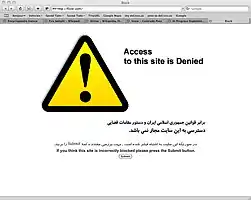Native name | شبکه ملی اطلاعات |
|---|---|
| Formerly | National internet |
| Type | National intranet, Government project |
| Industry | Computer network |
| Founded | 2016[1] |
Area served | Republic of Iran |
Key people | Mohammad-Javad Azari Jahromi, Abolhassan Firouzabadi,[2][3] Rasoul Saraian[4] |
| Owner | Government of the Islamic Republic of Iran |
| ASNs | |
| Traffic Levels | 18000 Gbit/s[5] |
| Website | rrk |
The National Information Network (NIN) (Persian: شبکۀ ملی اطلاعات, Shabake-ye Melli-ye Ettelā'āt), also known as National Internet in Iran and the Iranian intranet, is an ongoing project to develop a secure, stable infrastructure network and national intranet in Iran.
The Supreme Council of Cyberspace of Iran defines the NIN as "a network based on the Internet Protocol with switches and routers and data centers which allows for data requests to avoid being routed outside of the country and provides secure and private intranet networks."[6]
The idea of a national intranet was developed at the Ministry of Information and Communication Technology in 2005, and the project started in 2013.[7][8][9] It is based on the Fifth Economic Development Plan of Iran.[10]
The Iranian government allocated about $200 million to develop NIN infrastructures alongside NIN e-content.[11] Iranian president Hassan Rouhani signed an engineering program in September 2020.[12] According to the Iranian government, one of the NIN's main objectives is to break the monopoly of the Internet.[13]
Cisco Systems routers and switches were deprecated because of the program.[14] It has full independence.[15]
Iranian seventh quinquennial development program directed the Ministry of ICT to make it to 99% of the network within 5 five years.[16]
Deployment

The National Information Network's two main parts are:
- A public sector for delivering NIN services to public and business users
- A private sector for delivering NIN services to governmental users.
Everyone is identified by their social ID and telephone numbers before being able to access the network or internet through the network.[17] The Iranian government fully implemented the NIN between 15 and 27 November 2019,[18] during the 2019 Internet blackout in Iran.
Corporations are required to use only Iranian data centers and register their IP address.[19]
NIN can be used similar to the Great Firewall.[20]
In 2019, Mohammad Ali Movahedi Kermani in Tehran declared in a Friday prayer that Telegram is haram and requested the NIN to be implemented.[21]
Further reading
- ICT Infrastructure (National Information Network) in capable delivery of content in Iran and exemplary countries[22]
See also
References
- ↑ "فاز اول شبکه ملی اطلاعات در ایران افتتاح شد - BBC Persian". 28 August 2016. Archived from the original on 2017-06-30. Retrieved 2020-09-18.
- ↑ "Treasury Targets Human Rights Abuses, Censorship, and Enhanced Monitoring by the Iranian Government | U.S. Department of the Treasury". Archived from the original on 2020-09-17. Retrieved 2020-09-18.
- ↑ "ریاست مرکز". Archived from the original on 2020-02-28. Retrieved 2020-09-18.
- ↑ "انتصاب رسول سراییان به عنوان معاون وزیر ارتباطات و رییس سازمان فناوری اطلاعات | خبرگزاری ایلنا". Archived from the original on 2020-09-18. Retrieved 2020-09-18.
- ↑ "ظرفیت هسته شبکه ملی اطلاعات به 18 هزار گیگابایت افزایش یافته است". 27 May 2020. Archived from the original on 2020-09-19. Retrieved 2020-09-19.
- ↑ "1640". www.rrk.ir. Archived from the original on 2017-08-14. Retrieved 2017-07-08.
- ↑ Jafari, Hamed (2016-08-29). "Iran Initiates the First Phase of the National Information Network". TechRasa. Archived from the original on 2017-09-08. Retrieved 2017-07-08.
- ↑ Tajdin, Behrang (2013-04-27). "Will Iran's national internet mean no world wide web?". BBC News. Archived from the original on 2017-05-24. Retrieved 2017-07-08.
- ↑ "The National Information Network (National Internet) – Center for Human Rights in Iran". www.iranhumanrights.org. 10 November 2014. Archived from the original on 2017-07-17. Retrieved 2017-07-08.
- ↑ "Iran launches National Information Network". Mehr News Agency. 2016-08-28. Archived from the original on 2017-06-18. Retrieved 2017-07-08.
- ↑ "Cuts and Extensions in Iran's ICT 2017/18 Budget". Financial Tribune. 2016-12-13. Archived from the original on 2016-12-20. Retrieved 2017-07-08.
- ↑ "طرح کلان و معماری شبکه ملی اطلاعات تصویب شد - ایرنا". Archived from the original on 2020-09-18. Retrieved 2020-09-16.
- ↑ "national information network". Archived from the original on 2020-09-18.
- ↑ ""سیسکو" با شبکه ملی اطلاعات ایران وداع کرد- اخبار اجتماعی تسنیم - Tasnim". خبرگزاری تسنیم - Tasnim (in Persian). Archived from the original on 2020-09-18. Retrieved 2020-09-18.
- ↑ "الزامات شبکه ملی اطلاعات". www.majazi.ir. Retrieved 2021-05-20.
- ↑ https://tejaratnews.com/startup/%D8%A7%DB%8C%D9%86%D8%AA%D8%B1%D9%86%D8%AA-%D9%85%D9%84%DB%8C-%D9%88-%D8%B4%D8%A8%DA%A9%D9%87-%D9%85%D9%84%DB%8C-%D8%A7%D8%B7%D9%84%D8%A7%D8%B9%D8%A7%D8%AA-1402
- ↑ "کاربران ایرانی به زودی احراز هویت میشوند". ITIRAN | آی تی ایران (in Persian). 2018-12-14. Archived from the original on 2019-12-18. Retrieved 2020-04-16.
- ↑ "Partial internet disruption registered in Iran". NetBlocks. 2019-12-25. Archived from the original on 2020-04-17. Retrieved 2020-04-27.
- ↑ "The_National_Internet" (PDF). Archived (PDF) from the original on 2016-04-05.
- ↑ "وقتی چین با شبکه ملی اطلاعات، جلوی چالش های فضای مجازی را گرفت- اخبار خواندنی - اخبار رسانه ها تسنیم - Tasnim". خبرگزاری تسنیم - Tasnim (in Persian). Archived from the original on 2020-09-18. Retrieved 2020-09-18.
- ↑ "خطیب جمعه تهران: تلگرام حرام است؛ مانند چینیها عمل کنیم". Archived from the original on 2020-10-13. Retrieved 2020-11-09.
- ↑ Abolghasem, Rajabi. "ICT Infrastructure (National Information Network) in capable delivery of content in Iran and exemplary countries". Islamic Parliament Research Center of the Islamic Republic of IRAN. Archived from the original on 2017-02-08. Retrieved 2020-09-18.